Research Reports
Where White Men Rule: How the Secretive System of Forced Arbitration Hurts Women and Minorities
June 2021Highlights
- Arbitrators are mostly male and overwhelmingly white. Women and minorities are more likely than white men to be forced into arbitration, which prevents them from having judges and juries hear their cases.
- Corporate defendants disfavor female and minority arbitrators.
- When they do oversee cases, female arbitrators rule in favor of consumers and employees more often than male arbitrators.
In 2018, musician Jay-Z found himself in a legal dispute with the clothing company Iconix. Unable to reach a resolution, the parties took their dispute to arbitration with the American Arbitration Association (AAA), where it hit an unusual stumbling block. When given a roster of arbitrators to choose from, Jay-Z’s legal team realized there was not a single Black arbitrator among them.1
When the legal team pointed out that Jay-Z was Black and asked for “neutrals of color,” AAA responded by suggesting a further slate of six arbitrators who were minorities. However, only three of those were Black, one of whom was a partner at the law firm representing Iconix in the underlying arbitration.
The case shone a light on the normally shadowy world of arbitration. While federal and state judiciaries have struggled for years with the lack of representation within their ranks, they are positively diverse compared to arbitration.
Arbitrators in consumer and employment cases are mostly male and overwhelmingly white. At AAA and JAMS, the two largest consumer and employment arbitration providers in the country, 88% of arbitrators are white and 77% are male.2 And that’s as diverse as it gets. In 2019, members of the National Academy of Arbitrators determined that over the organization’s 72-yearhistory only 35 Black, Indigenous, and people of color (BIPOC) had been admitted, just 2% of the overall membership.3
To put this into perspective, individuals who identify as BIPOC make up nearly 40%, and women make up 51%, of people living in the United States.4
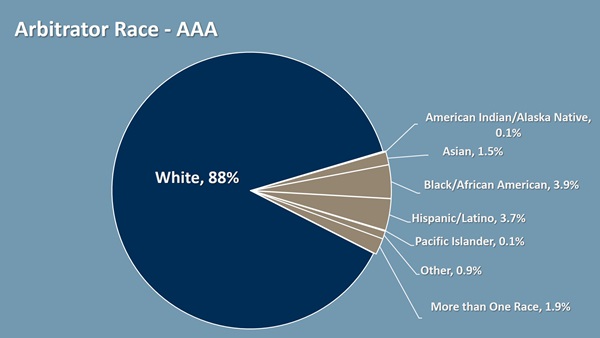
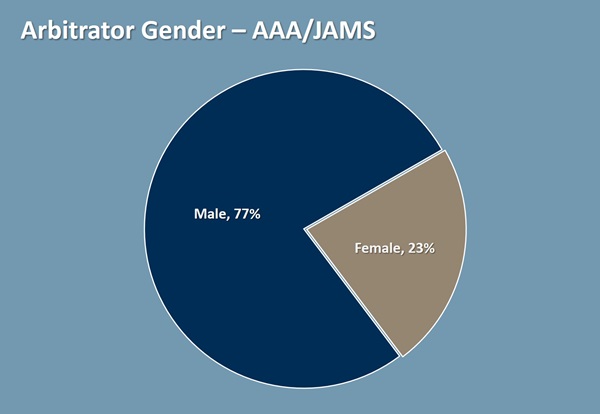
Few people realize that forced arbitration provisions eliminate their constitutional right to a trial before a jury of their peers.5 But for minorities and women, forced arbitration not only eliminates the jury but also all but ensures their case will be decided by a white male. A consumer is more likely to be struck by lightning than win a monetary award in forced arbitration as it is; being Black or female reduces their prospects even further.6 Take for example a recent Tesla case, in which a Black employee detailed suffering at least a dozen instances of racial slurs and threats, including video of coworkers threatening him while using the n-word. Though Tesla CEO Elon Musk apologized to the employee, agreed changes needed to be made, and offered to settle the case, Tesla eventually took the case to arbitration, where a white arbitrator ruled that the slurs weren’t racist and were more “consistent with lyrics and images commonly found in rap songs.”7
Women and Minorities are Most Affected by Forced Arbitration
The lack of diversity in arbitration is a problem made worse by the fact that women and minorities are more likely to be subject to forced arbitration than men or white, non-Hispanic workers.
Roughly 60 million workers are subject to forced arbitration provisions at their place of employment, whether they realize it or not.8 But some fields of employment are more affected by forced arbitration than others. For instance, research has shown that construction, an industry with a predominantly male workforce, has the lowest rate of forced arbitration, whereas education and health, industries with a more predominantly female workforce, have the highest rate.9
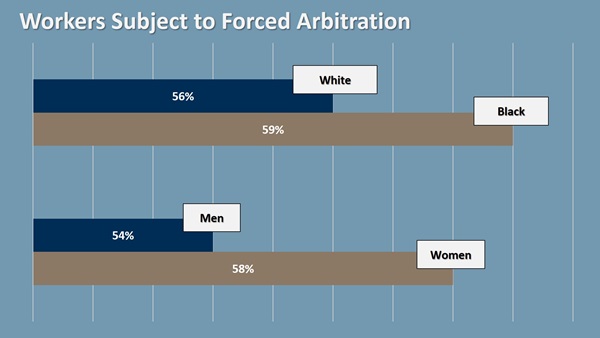
Income is also a factor. Lower-paid workers are more likely to be subject to forced arbitration than more highly-compensated employees. Minorities and women are not only more likely to work in fields that render them subject to forced arbitration but also tend to earn less overall. Black men earn an average of 87 cents for $1 earned by white men.10 Women receive even less, earning 82 cents for every $1 earned by men.11
The result is that minorities and women are disproportionately forced into a dispute resolution system that is decidedly not of their peers.12
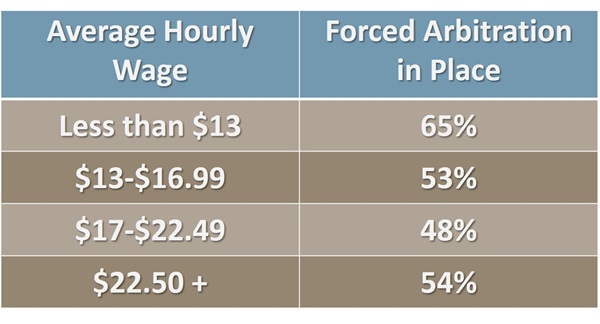
Sexual Harassment
The gender disparity within the arbitration world is of particular concern when it comes to sexual harassment claims and other employment issues. The various scandals that resulted in the development of the #MeToo movement highlighted how corporations had been using forced arbitration—in which the arbitrators are almost always male—to silence women who had been sexually harassed. Forced arbitration does this not only through its secretive nature but by including class waivers, which stop group actions that would be the equivalent of class actions. Women who are exposed to patterns of sexual harassment are on their own and cannot come together to challenge workplace disputes. Individual cases are settled confidentially, leaving the perpetrators free to continue the same behavior.
In testimony at a February 2021 hearing on forced arbitration before the U.S. House Judiciary Subcommittee on Antitrust, Commercial and Administrative Law, former Fox News anchor Gretchen Carlson highlighted how her employer had tried to use a forced arbitration clause to silence her after she was fired for reporting sexual harassment by her then-boss, Roger Ailes. By refusing to be quiet, Carlson helped prompt other women to come forward with allegations against other media figures, including Bill O’Reilly, Charlie Rose, Les Moonves, and others.13
If arbitration is ever to be a credible means for justice, it cannot, as it is currently, be a tool to silence victims of workplace harassment and discrimination. In employment cases resolved by AAA between 2016 and 2020, the top 10 most frequently-used male arbitrators—all of whom are white—awarded monetary damages to employees in just 2.1% of cases (JAMS does not reveal arbitrator names). Female arbitrators, on the other hand, awarded monetary damages 3.4% of the time. Female arbitrators also tended to award higher damages than their male counterparts.14
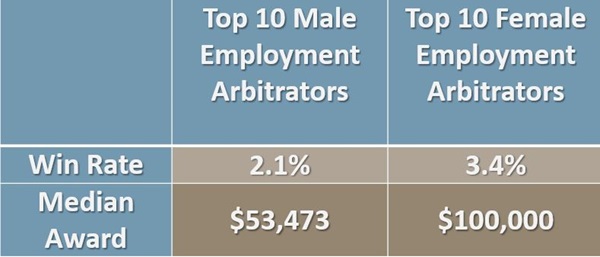
Lack of Diversity in Age and Sexual Orientation
The lack of diversity within arbitrator ranks shows up in other areas too.
At AAA, 2% of arbitrators identified as non-heterosexual, while in the U.S. as a whole, 6% of Americans identify as LGBTQ (sexual orientation was also the demographic question AAA’s arbitrators were least likely to answer, with more than half of all arbitrators refusing to disclose).15

The age of arbitrators also skews far older than the population as a whole, in part because arbitrators tend to become arbitrators only after long careers in the legal profession. Neither AAA nor JAMS reveal arbitrator ages, but another arbitration provider—the Financial Industry Regulatory Authority (FINRA), the private corporation that handles arbitration cases arising out of brokerage disputes—does. While it suffers from an almost duplicate lack of diversity with regard to gender and race (7 out of 10 FINRA arbitrators are male and 8 out of 10 are white), its arbitrators skew mature—75% are aged 60 or older, and 44% are 70 or older.16 Such homogeneousness is the reason the arbitration world is so often described as “pale, male, and stale.”
Minority and Female Arbitrators are Frozen Out
Many commentators blame the lack of diversity on the legal profession as a whole—if representation is poor within the legal profession, particularly the corporate and big law world from which arbitrators tend to come, they are unlikely to ever become arbitrators.17 However, there is no reason why arbitration providers could not recruit from areas of the legal profession that better reflect society as a whole—for instance, civil rights lawyers. In fact, arbitrators are not required to be lawyers, judges, or have any legal training at all.
Minority arbitrators also face a Catch-22: how can they develop a career as an arbitrator if the parties will not select them? Corporate defendants are known to strike minority arbitrators when given a panel of potential candidates. Smith v. American Arbitration Association evolved from an arbitration in which a female claimant, Lisa Smith, found herself presented with a list of 15 potential arbitrators to oversee her dispute. Fourteen of the proposed arbitrators were men, and the lone female, whom Smith had listed as her first choice, was immediately struck by the defendant corporation, rendering the “diverse” panel moot (the United States Court of Appeals for the Seventh Circuit saw no problem with the arrangement and ruled in favor of AAA and its corporate client).18
In another instance, a female arbitrator, who held both an active legal practice and a master’s degree in dispute resolution, was passed over by AAA, while her white husband, with no legal practice or arbitration experience, was invited to join AAA. The reason given? The female arbitrator wasn’t expected to generate enough business. When she complained, that arbitrator was also told that AAA’s construction arbitration panel, “stopped putting Blacks on the panel because no one hires them.”19
Conclusion
Trust in the civil justice system is enhanced when the public sees that the judges deciding their cases reflect the diverse racial, ethnic, and cultural background of American society. As such, there have been, and continue to be, significant efforts to increase diversity in the federal judiciary. But the arbitration world is far behind even the judiciary. As Texas A&M University School of Law professor Michael Z. Green wrote, “the lack of diversity in the arbitrator pool may cause black employees to not pursue their discrimination claims out of a feeling that it would be futile in such a questionable system.”20
Federal and state courts face similar issues with regard to diversity but there is one major difference in arbitration. In the courts, whatever the race of the judge, a plaintiff can still face a jury. In arbitration, the arbitrator is judge and jury. And the process of selecting an arbitrator undergoes far less scrutiny than the same process for selecting a jury. Instead, forced arbitration is dominated by a small number of judges, retired judges, and corporate lawyers who have carved out a niche for themselves aiding businesses in avoiding civil jury trials, EEOC proceedings, and any other potentially public forum of justice.
For claimants like Jay-Z, facing a white arbitrator is like facing a white judge and a white jury. There is little chance of a proceeding in front of one’s peers.
- Jay-Z Halting His $204M Lawsuit Over a Lack of Black Arbitrators Could Be Historic, The Observer, November 29, 2018, https://observer.com/2018/11/jay-z-halts-lawsuit-black-arbitrators-historic/.
- Arbitrator Demographic Data, American Arbitration Association, as of March 31, 2021; JAMS Panelist Survey 2021, as of March 31, 2021.
- Diversity and Inclusion in Arbitrator Selection or “I Select Who I Know,” American Bar Association, 2019, https://www.americanbar.org/content/dam/aba/events/labor_law/2019/annual-conference/papers/diversity-and-inclusion-in-arbitrator-selection.pdf.
- Building a More Inclusive Federal Judiciary, Center for American Progress, October 3, 2019, https://www.americanprogress.org/issues/courts/reports/2019/10/03/475359/building-inclusive-federal-judiciary/.
- Jeff Sovern, Elayne E. Greenberg, Paul F. Kirgis, Yuxiang Liu, Whimsy Little Contracts with Unexpected Consequences: An Empirical Analysis of Consumer Understanding of Arbitration Agreements, University of Maryland Law Review, 2015, https://digitalcommons.law.umaryland.edu/mlr/vol75/iss1/2/.
- The Truth About Forced Arbitration, American Association for Justice, September 2019, https://www.justice.org/resources/research/the-truth-about-forced-arbitration.
- Arbitration 2.0: Inside the secretive legal battle dividing Silicon Valley, Protocol, February 24, 2020, https://www.protocol.com/tesla-racism-claims-arbitration.
- The growing use of mandatory arbitration, Economic Policy Institute (EPI), April 6, 2018, https://www.epi.org/publication/the-growing-use-of-mandatory-arbitration-access-to-the-courts-is-now-barred-for-more-than-60-million-american-workers/.
- The growing use of mandatory arbitration, Economic Policy Institute (EPI), April 6, 2018, https://www.epi.org/publication/the-growing-use-of-mandatory-arbitration-access-to-the-courts-is-now-barred-for-more-than-60-million-american-workers/.
- Black Workers Still Earn Less than Their White Counterparts, SHRM, June 11, 2020, https://www.shrm.org/ResourcesAndTools/hr-topics/compensation/Pages/racial-wage-gaps-persistence-poses-challenge.aspx.
- The State of the Gender Pay Gap in 2021, Payscale, 2021, https://www.payscale.com/data/gender-pay-gap#section14.
- The growing use of mandatory arbitration, Economic Policy Institute (EPI), April 6, 2018, https://www.epi.org/publication/the-growing-use-of-mandatory-arbitration-access-to-the-courts-is-now-barred-for-more-than-60-million-american-workers/.
- Justice Restored: Ending Forced Arbitration and Protecting Fundamental Rights, House Committee on the Judiciary, February 11, 2021, https://judiciary.house.gov/calendar/eventsingle.aspx?EventID=3530.
- AAJ analysis of AAA closed claims data.
- LGBT Identification Rises to 5.6% in Latest U.S. Estimate, Gallup, February 24, 2021, https://news.gallup.com/poll/329708/lgbt-identification-rises-latest-estimate.aspx; Americans Still Greatly Overestimate U.S. Gay Population, Gallup, June 27, 2019, https://news.gallup.com/poll/259571/americans-greatly-overestimate-gay-population.aspx.
- Our Commitment to Achieving Arbitrator and Mediator Diversity at FINRA, FINRA, https://www.finra.org/arbitration-mediation/our-commitment-achieving-arbitrator-and-mediator-diversity-finra.
- Lack of Arbitrator Diversity Is an Issue of Supply and Demand, Bloomberg, May 15, 2019, https://news.bloomberglaw.com/daily-labor-report/lack-of-arbitrator-diversity-is-an-issue-of-supply-and-demand.
- Smith v. American Arbitration Association, Inc., United States Court of Appeals, Seventh Circuit, No. 00-1204, decided: September 25, 2000, https://caselaw.findlaw.com/us-7th-circuit/1493437.html.
- The Hypocrisy of the Law’s Diversity “Efforts,” She Negotiates, July 10, 2020, https://www.shenegotiates.com/blog/2020/7/10/boiling-mad-about-diversity-efforts-in-the-law.
- An Essay Challenging the Racially Biased Selection of Arbitrators for Employment Discrimination Suits, Journal of American Arbitration, 2005, https://scholarship.law.tamu.edu/facscholar/626/.
Contact AAJ Communications by phone at 202.684.9588 or email media.replies@justice.org. Contact Us

